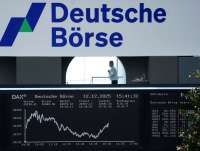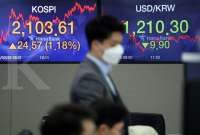GLOBAL MARKET - NEW YORK. Stocks around the world rebounded on Friday, the U.S. dollar fell and oil prices dipped as investors welcomed talk of renewed diplomacy after Russia's invasion of Ukraine, and as coordinated Western sanctions left Russia's energy sector largely untouched.
On Thursday, worries about the invasion lifted oil prices past $100 a barrel for the first time since 2014.
Wall Street's indexes extended the previous session's rally with Nasdaq and the S&P 500 registering gains for the week.
The MSCI World Index closed up 2.43%; for the week it was down 0.7%.
Russian President Vladimir Putin urged Ukraine's military to overthrow its political leaders and negotiate peace. Authorities in Kyiv called on citizens to help defend the capital.
Read Also: OPEC+ Deal Seen on Track Despite Russia's Ukraine Invasion -Sources
EU countries agreed to freeze European assets of Putin and his foreign minister, Sergei Lavrov, and the White House announced plans for U.S. sanctions. Read full storyRead full story Ukrainian President Volodymyr Zelenskiy pleaded for faster and more forceful sanctions.
China's Foreign Minister Wang Yi said China respects Ukraine's sovereignty and Russia's security concerns, and it welcomes direct Russia, Ukraine dialogue as soon as possible.
Russia said it was ready to send a delegation for talks with Ukraine, but U.S. State Department spokesperson Ned Price called this an attempt to conduct diplomacy "at the barrel of a gun,".
"Markets went through a progression. They heard the word invasion Wednesday night and started selling. Then markets heard the word sanctions Thursday and started buying. Then they heard the word diplomacy on Friday and kept buying," said John Augustine, chief investment officer at Huntington National Bank in Columbus, Ohio.
Some investors remained wary of riskier assets, weeks before the Federal Reserve is expected to raise U.S. interest rates.
"The market is purely looking at the short run, saying that what they feared has happened so there's nothing else to fear on the invasion of Ukraine ... that's being pretty shortsighted," said Chris Zaccarelli, chief investment officer at Independent Advisor Alliance in Charlotte, North Carolina.
Read Also: Mainland China Posts Highest Number of Imported Covid Cases in Nearly 2 Years
Zaccarelli is turning his focus on "what the Federal Reserve is going to do. ... raise rates to a higher level than people believe in order to combat inflation."
The Dow Jones Industrial Average finished up 2.51% after closing 0.28% higher on Thursday while the S&P 500 gained 2.24% after rising 1.5% the previous day and the Nasdaq Composite added 1.64% after rallying 3.3% on Thursday.
Russia's main stock index closed up 20% on after Thursday's record 33% drop. Gains pared somewhat in after-hours trading with the index last up around 15%.
OIL PRICES DROP
Brent crude settled at $97.93 per barrel, down 1.16%, while U.S. West Texas Intermediate crude settled down 1.3% at $91.59.
Safe haven gold dropped 0.8% to $1,887.24 an ounce. On Thursday it had jumped to $1,973.96, its highest since September 2020.
The yield on 10-year U.S. Treasury notes dipped 0.7 basis points to 1.965%. The two-year Treasury yield, which typically moves in step with interest rate expectations, was up 2.2 basis points at 1.568%.
Read Also: Futures Dive as Russia Invades Ukraine; Nasdaq Bear Market in Sight
"The bond market is trying to guess what Fed Chair Powell is going to say next week in his congressional testimony. The bond market has moved on to the Fed. Global geopolitcal risks in the eyes of the dollar and gold have lowered," said Huntington's Augustine.
The U.S. dollar dipped a day after notching its biggest daily percentage gain in more than three months. Investors bet sanctions on Russia and U.S. inflation data would probably keep the Fed cautious about hiking rates too quickly.
The dollar index fell 0.589%, with the euro up 0.73% to $1.1273.
The Russian rouble rose to 83.54 per dollar, clawing back from the previous session's record low of 89.986.
U.S. economic data on Friday showed consumer spending increased more than expected in January even as price pressures mounted, with annual inflation hitting rates last seen four decades ago
/2021/11/09/43322546p.jpg)









